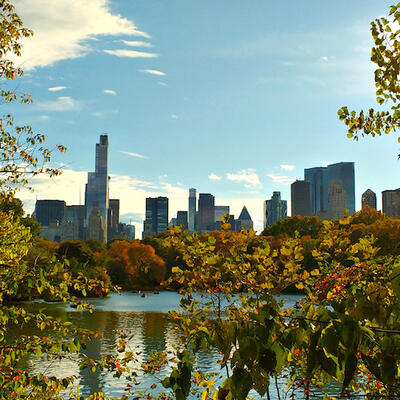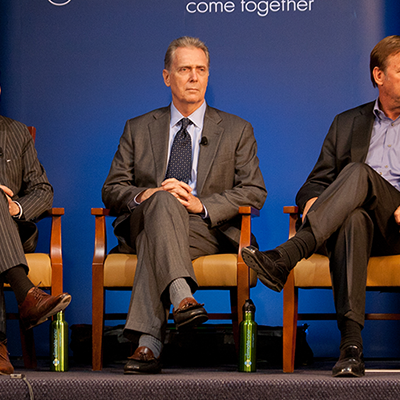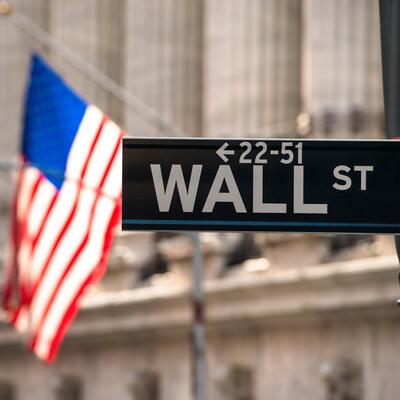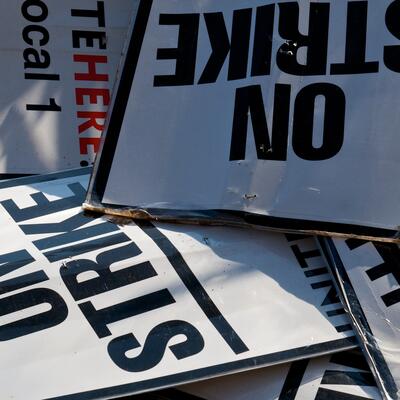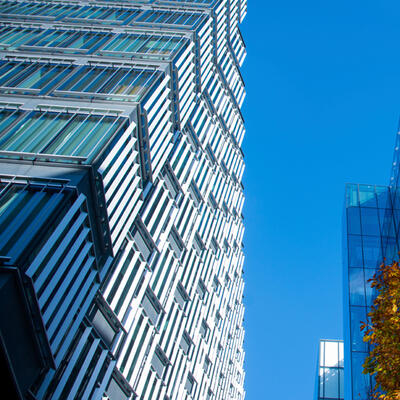
Clean Communities
Guests
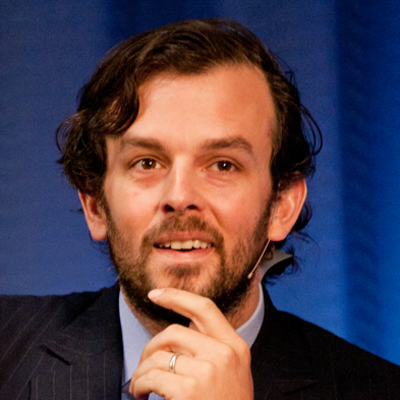
Alex Mehran Jr.
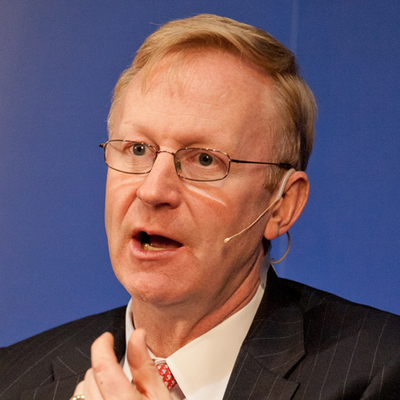
Carl Shannon
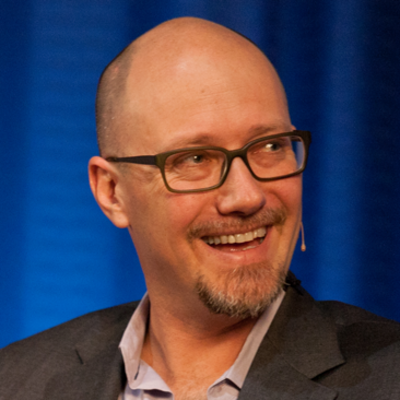
Gabe Metcalf
Summary
Coastal cities “are facing an existential threat that we are not prepared to deal with,” said Gabriel Metcalf, the Executive Director of San Francisco Planning and Urban Research Association (SPUR). The California Bay Area is wrestling with a challenge as it tries to develop sustainably to accommodate a growing population in a warming world. One way to deal with population rise and reduce emissions is to create “zones of high density” says Alex Mehran Jr., Senior VP and General Manager at Sunset Development. Carl Shannon, Managing Director at Tishman Speyer says “you have to find the right balance of economic desire and political will” to develop high density zones in traditionally suburban environments. The experts agree that the key to sustainable growth in the Bay Area is rebuilding for a more walkable and livable urban environment. Three leaders in sustainable building and development discuss Bay Area development goals.
Full Transcript
Greg Dalton: Welcome to Climate One, a conversation about America's energy, economy, and environment. To understand any of them, you have to understand them all. I'm Greg Dalton.
Today, we're discussing smart growth in the Bay Area in the era of rising population and rising tides. Another million people are projected to move to the region in coming decades bringing new demand for housing and jobs. At the same time, climate reality suggests the usual ways of growing won't service well in the future due to pressures to reduce greenhouse gas emissions and the need to brace for severe weather.
Over the next hour, we will look at building a prosperous and resilient Bay Area with our live audience at the Commonwealth Club in San Francisco. We're pleased to have with us three people actively shaping the region's future. Alex Mehran, Jr. is general manager at Bishop Ranch, which is owned by the Sunset Development Company; Carl Shannon is senior managing director at Tishman Speyer, a developer of urban offices and condominiums; and Gabe Metcalf is executive director of SPUR, a nonprofit urban planning organization. Please welcome them to Climate One.
[Applause]
Greg Dalton: Thank you all for coming. I'd like to talk a little bit before we get into development and the future of smart growth in the Bay Area, how you came to development and sustainable development in particular. So let's start with you, Carl Shannon.
Carl Shannon: Sure. I mean, at Tishman Speyer, we really want to play and develop in cities with high barriers to entry, the 24/7 cities that we really see as being the future in the planet and to take that role seriously to be involved in those communities.
Doing that from a thoughtful and sustainable perspective is critical to us. And so that commitment runs through our culture and each of us. I run the Bay Area for Tishman Speyer. Each of us around the world approaches that from an individual perspective, but it's throughout the firm's culture.
Greg Dalton: Gabe Metcalf, you've been doing and thinking about this a very long time. When did you first come to really think about sustainable development?
Gabriel Metcalf: Well, I come to this in two ways. First is the simple fact that I love cities — the energy and the diversity and the excitement and the mix of all these people doing these crazy things you'll never even know a tiny fraction of. So I love cities, and that's the happy way I came to this. But I also came to this from, I think, what is a less happy angle, and that's a — in my generation, we know that the problem of our time is climate change. And if we continue to build this country the way we have in a suburban format, there will be so much carbon in the atmosphere from that way of life that the seas will rise and there will not be a San Francisco or a New York or a Los Angeles or a Seattle, or a Shanghai or a London or Cairo.
The cities of the world on the coasts are facing an existential threat that we are utterly unprepared to deal with. And so there is a happy side to this, there's also an apocalyptic side to how I come to this.
Greg Dalton: And we'll get to both of those, that's why we're doing this program, to talk about how cities are part of the problem and can be part of the solution. Alex Mehran, you grew up in the land business third generation. How did you come to think about sustainability and land development?
Alex Mehran: We've been a suburban developer since the early 50's. And in all our communities we've tried to mitigate some of the — we're not building in cities but we try to mitigate some of the issues by creating locations with good land planning, a lot of sustainable initiatives, transit-oriented, and other things to have a really high quality location, which can mitigate some of the issues that most suburban location suffer from. And so I think that's been a key element in all our developments.
Greg Dalton: So let's think about the Bay Area looking out. A million people, 600,000 homes. How is that going to happen — how is the Bay Area going to grow in a climate smart way so that those homes both are protected from what we know that's coming in terms of climate change and don't make the problem worse? Carl Shannon?
Carl Shannon: From our perspective, I think it's about trying to build those homes — our focus as a developer, I think, is more in trying to deal with the cause of the problem and limiting the carbon more than it is how to deal with the symptom. And for us, that's really about building housing and jobs near each other and near transit, that if we can build 650 homes at The Infinity in downtown San Francisco, that 650 homes that aren't built in mountain home or Antioch or Novato, and we don't have those people driving in their cars coming into the city; they're literally walking from The Infinity to their jobs in downtown.
So while it is challenging economically, putting housing and jobs near each other and creating really vibrant 24/7 communities, I think, is, from a developer's perspective, one of the most important things we can do. And we are big believers in what is going on in San Francisco. While I think San Francisco is fairly unique, the energy of what is happening today in San Francisco is remarkable from our perspective.
Greg Dalton: Let's talk about that. Around the Transbay Terminal, there's supposed to be what — 20,000 new homes, there's going to be maybe high-speed rail, maybe not but there's going to be some transit infrastructure. Is that sort of the thing that you think more cities ought to do?
Carl Shannon: Yeah. I think that you have a very wonderful mix coming together. And partly it's about the transit terminal itself, partly it's about a relatively rich transit environment to start with, with BART and MUNI already here. And you have a whole generation of people today in their 20's and 30's, people who go to the best colleges in the country. And rather than saying, "Okay. I'm going to take the best job I can," they pick where they want to live. And San Francisco has the right chemistry of the right neighborhoods and the right feeling and it's a progressive city, it’s environmentally sensitive city. And you have people coming to live in San Francisco as sort of their primary decision. And then they find the best job that they can.
And some of those people, yes, are getting on the Google bus and driving down to Mountain View and they're getting on the Apple bus and going down to Cupertino everyday. But increasingly, I think you see those people.
And if they have a choice, once they come here and they're working for Google or Apple and their roommate or their neighbor or somebody they had coffee with says, "You should come work for Dropbox or you should come work for Sales Force," you're seeing in a way that we've never seen before in San Francisco. These tech companies really take root here not because they like the political climate, not because the taxes are low and it's an easy place to do business, but because they want and need access to those employees. And if you look at the sort of P&L statement of a tech company, getting the right employees is much more important than the taxes or the rent that you're paying.
So I think you see people — you see companies coming in to San Francisco. I mean, our leasing guy will get calls from brokers with 650 or 408 area code once a week with "I got a 50,000-square-foot requirement that didn't exist in San Francisco” that wants to come look. And they're doing that because they want the employees. And I think that chemistry, which Ed Lee has done a lot to try and reinforce, is very special. And we are really creating a great 24/7 city here.
Greg Dalton: Gabe Metcalf, do you agree? It sounds like San Francisco is doing a lot of things right. Or just getting lucky.
Gabriel Metcalf: Both, but I think San Francisco is doing a lot of things right. We got lucky that Silicon Valley grew up just to ourselves and sort of colonized the city's economy and saved our bacon. I think the growth needs to be really seen as an opportunity. I mean, the world's population is growing from 6 billion or so today, 9 or 10 billion, but its very unevenly spread. Europe is not growing. Japan is not growing. The regions of the United States that are growing have the opportunity to take all that growth, and we can rebuild our communities — both our cities and our suburbs — so that they become more walkable. So that they are organized into nodes where transit can serve them. This growth provides us with the opportunity to retrofit the past mistakes we've made. And I think San Francisco right now is doing a really good job of that.
Greg Dalton: But San Francisco can't do it alone. Let's talk about some of the other regions where there's going to be a million people, maybe what, 100,000 can — there's 100,000 units in the pipeline supposedly in San Francisco. What about the rest of the Bay Area that maybe can't do things like San Francisco or don't want to? Alex Mehran, some people want to live out in Danville, East Bay, et cetera, they don't want that urban lifestyle.
Alex Mehran: Yeah. And I think something that's important to point out is that the reason for that demand to go out there isn't just about the cost of the houses. It's about the cost of schools. If you live in the city and you have a job that Carl was describing, you'd probably want your kids to go to private school and that's just not tenable in the city. If you move out to the suburbs, there are better schools, so there's an opportunity for better public schools and there's an opportunity to take advantage of that. And so we really feel that creating nodes in the suburbs with substantial infill development, retrofitting suburbia as you said, where you can create high density in the suburbs with specific nodes where there's jobs and houses, and you can get that convergence and reduce the amount of trips in vehicles is important, I think, to think about.
Greg Dalton: Are there some places where that's happening now? If we look at suburbia, Gabe Metcalf, is there a place where you would say that this is the direction that retrofitting suburbia might go?
Gabriel Metcalf: Well, I think Bishop Ranch is a really interesting example of a single landowner trying to think it through at scale. I also think that the city of San Jose, which you all should know is the biggest city in the Bay Area, more than a million people, very suburban in its pattern.
And it modeled itself on Los Angeles for many decades and annexed land, is trying to move at least some of its neighborhoods into a much more urban direction. The North San Jose, where a lot of the tech companies are, is trying to kind of reinvent a new form that can be better than the suburban office park. Downtown San Jose is trying to grow as much as it can. So I think there are examples here in the Bay Area.
Greg Dalton: But government can only do so much. And there's Santana Row down there which is one area that people kind of mentioned as a model of a place where people can kind of live and work. Carl Shannon, what do you see is the obstacles for that kind of development in San Jose? Is it on the demand side or is the supply side? Why isn't San Jose — can it become like San Francisco to get that urban mix you're talking about?
Carl Shannon: I think San Jose is trying very hard. And I think the redevelopment agency in San Jose got a lot of energy in downtown. The economics and the geography are different than they are in San Francisco. One of the challenges from an office standpoint, from a development standpoint, is that in downtown, parking is below grade or in structured parking that is expensive to build. And you are competing with office tenants on North 1st Street where the parking is in the surface parking lot. And the tenant will — there's an economic advantage. It's cheaper to be or has been cheaper to be in that product up off North 1st Street, the so-called Golden Triangle, than to be downtown. So you have to overcome that cost increment to draw the tenants downtown. And Adobe has been a great corporate citizen in leading the way, and has built a great corporate campus.
But you don't have the kind of critical mass that you have in San Francisco. So it continues to need very significant municipal help and support to continue. And really, in this last cycle was sort of the first time we built high-rise attached housing in downtown San Jose. It really didn't exist ten years ago. And in the 2006 to 2008 time frame, we finally built some attached housing in downtown San Jose. It didn't do terribly well, but it's there and you have residents, and it's beginning to take off. So I think it is actually a good model of how you can sort of densify in an environment. There are places where there is the economic demand, but there's not the political will. And so you look at something like downtown Palo Alto. If we could a 15-storey attached condominium project on University Avenue in downtown Palo Alto, we can sell that out overnight. But there's no political will in some of these smaller municipalities to see that kind of densification. I mean, Palo Alto has that living, thriving downtown that people want. It has office rents that are, quite frankly, some of the highest in the entire Bay Area and some of the highest values for the buildings in downtown Palo Alto. So economically the engine is there, but you have to find the right balance of the economic desire and the political will.
Greg Dalton: And Gabe Metcalf, you have to presume that people in Palo Alto get climate change, they get the carbon imperative and they'd like to solve the problem, just not in their backyard. People are not willing to make some personal tradeoffs for the common good.
Gabriel Metcalf: Yeah. I don't think they do get it because I just can't believe — I just can't believe that people understood the impacts of their actions. They would be making this choice that will be so murderous on future populations that the impact of allowing someone else to live in an apartment building, not even yourself having to live in it, but allowing it to be permitted, so that other people could live there, that that is too great that they won't — I just have to believe that human nature is better than that, that if they understood the impact of denying that, they would change their mind.
Greg Dalton: And they're not the only ones. There are other areas where city municipalities have opposed this denser housing. Peter Calthorpe was here and talked about how there were plans for Alameda to have some attached housing, et cetera. And people rejected that because of what — class, race, it's like “Oh, we don't want that because of the people it’s going to bring into our area.” What's going on there?
[Laughter]
Gabriel Metcalf: You tell me. There is somehow an idea in a lot of the Bay Area that you should not have to be inconvenienced by even seeing a new building within your line of sight. That that is too much to ask for the sake of fighting climate change. And I honestly — I know they're not Republicans. There are hardly any Republicans in the Bay Area, right?
Greg Dalton: No. The Sunset Park is —
Gabriel Metcalf: So I don't know what it is.
Greg Dalton: Western San Francisco, they want to keep that residential — private character, neighborhood character identity, and a little bit of "We got in here first, and close the door after us."
Gabriel Metcalf: Yeah.
Greg Dalton: Carl Shannon?
Carl Shannon: I do think that we see maybe on the positive kind of room, that demographically there is a real shift. And you look at sort of the development patterns in the period following the Second World War in the 50's, 60's and 70's, where the cities emptied out and people went out to the bucolic suburban lifestyle and they got these nice homes, and Alex’s grandfather built a lot of homes, and then we had the shopping centers and the businesses follow them to the suburbs. You're really seeing the people, the 20 and 30-somethings say that “No, I want to be in that richer urban environment.” And I get that there are a lot of political issues, particularly in the smaller suburban municipalities. But I think the demographics are changing, the attitudes are changing. There is a new generation that is much more inclined to stay in an urban environment, to raise families in urban environment. And there are issues with that: schooling issues— Gabe and I both know that on a personal front, very real. But I am optimistic that if you roll the clock forward and the people who are 20 and 30 years old today grow up and have children and take leadership roles in society, that they will do that from a much more environmentally sensitive, sustainable direction.
Greg Dalton: And one area that that's manifesting is vehicles, cars. We grew up sort of aspiring to — our car was a means of liberation, getting a car — that independence. These days, people have their smart phone. That's their vehicle for independence. They don't lust after cars the way that previous generations did, and they look at mobility as a service rather than some medal to own. And so Gabe Metcalf, how is car-sharing and vehicle miles traveled fitting into this because that's a big part of the greenhouse gas emissions of an urban area?
Gabriel Metcalf: Right. So here in the Bay Area the number I use — 40 percent of our emissions are from driving. If you look at the emissions from the manufacturing of the cars, it's bigger in terms of each of our personal carbon footprints. So the whole game in a place like the Bay Area is reducing the amount that people drive. And I tend to think that you can't really judge people's personal trip decisions. People do what is most convenient. And you really have to approach this from the land use side. You have to retrofit the land uses to make it that it's really convenient to bike or walk or take the train.
But I do think that we are experiencing a wave of innovation that deals with the kind of medium density of the Bay Area, at least parts of it. We're not New York. We're not a European city. We have transit, but it's very spotty, but it's sort of too crowded to drive easily. So we have that — we're kind of at this awkward in between density. And so I think City CarShare is probably the most important, but the Google buses are getting a drive-alone rate to a suburban campus in the middle of Mountain View that is essentially the same as the drive-alone rate to downtown San Francisco. It's extraordinary. I think this — what they would call dynamic ridesharing with Uber and Lyft and SideCar is really exciting as well. And I think there's probably — we probably have just scratched the surface of what we're going to be able to do there.
Carl Shannon: One of the things that's happening in real estate that I think plays into what you're talking about, in commercial real estate, in office buildings, the densities at which tenants are occupying space are being pushed to much higher densities. Fifteen years ago, you would plan an office building where you would have 3.5 people per thousand.
Gabriel Metcalf: Per thousand square feet.
Carl Shannon: Per thousand square feet. You now see today tech tenants pushing that number to seven, eight, nine, in some cases as high as ten people per thousand square feet. If you provide that office space in North Bayshore, in Mountain View, you have a parking ratio in your surface parking lot that maybe is four per thousand, it's probably 3.5 per thousand. You can't get the people there in cars. If you do it in downtown San Francisco and you put people in at seven, eight per thousand and they come on BART, they come on MUNI, you're making that happen, it's a much better fit for the tenants. The people who are in — the tenants who are in these traditional suburban environments are having to think outside the box, they're having to do the buses. Google is a huge proponent of the electrification of Caltrain. And part of the reason they want to do that is to improve the service on Caltrain, because they know that's critical to bringing people to North Bayshore.
We also see from a value standpoint — we built a building in downtown Mountain View, started in 2000, delivered in 2002. When we did, being walking distance from the Caltrain was kind of a nice to have. It was a little bit of benefit, it was a good thing, but it didn't differentiate the rate between being on Castro Street walking distance from train station and being off the shoreline in North Bayshore. Today there is a real difference in these peninsula communities between the rent for office space that's walking distance from the train station than there is something that's not, in large part because you have these people who live in San Francisco and take the train down. If they take the train down and walk to their job, that's great. If they take the train down and then they need to wait for a jitney to pick them up, it's a different thing. So I think you're seeing it translate into rent and into value, which will incent the development community to do the right thing.
Greg Dalton: So we're seeing culture and policy. One thing that policy has done in San Francisco is to try to put a squeeze on parking in residential and commercial development. Sometimes developers squeal at that saying, "You're killing us." But is that ultimately a not so bad thing, Carl Shannon, to have some constraints on parking so that — it seems like the market is going in this direction toward less vehicle bays.
Carl Shannon: Yeah. San Francisco has been a “transit first” city since what, 1987, '88.
Gabriel Metcalf: Seventy.
Carl Shannon: Okay. The real parking regulations came into play — look, from a market standpoint, if you talk to a condominium buyer or an office tenant, they always want as much parking as you can give them. So we need to find the right balance but we are big supporters in general of what the city is trying to do from a Transit First policy. We just need to marry that with the market reality of providing the space and the units to people who will buy them. But the short answer is yes, we're very supportive of what the city is trying to do.
Greg Dalton: Gabe Metcalf?
Gabriel Metcalf: On parking?
Greg Dalton: Yeah. Parking, yeah, right, as a constraint to drive —
Gabriel Metcalf: Yeah. My tendency is to think if you get the land uses right, so there's a mix of uses, it's really high density, really walkable, and you get the transit, then you don't really have to worry about the parking. You can kind of — if you build a lot of parking, it sort of itself correcting because the streets just gets completely congested and people stop driving for that reason. And I think you really want to focus on making the sidewalks nice, making the ground floors of the buildings nice, building at really high densities. And then you want to focus on the transit piece.
Greg Dalton: And how about electric cars? Does is matter what kind of cars people drive? Obviously, gasoline is a big part of greenhouse gas emissions. Here in the Bay Area, our electricity is fairly clean, coming from hydros, some geothermal, increasingly solar. Can we keep the car if they're cleaner cars, Gabe Metcalf, or as we got to —
Gabriel Metcalf: Well, a lot of the carbon impact of a car is in the manufacturing of the car rather than the driving of the car. So if you move toward cleaner cars, you're dealing with part of the problem. There's also the carbon impact of building all the roads. There's also the impact on walkability, of spreading the destinations further apart to accommodate all the cars. So absolutely, we should push for cleaner cars but it is a mistake to think that that solves the problem.
Greg Dalton: Well, electric cars can't go very far so you might solve it that way. Range anxiety kind of keeps you close, right?
Gabriel Metcalf: Yeah.
Greg Dalton: I can't go more than 100 miles in my Nissan Leaf. Let's talk about Oakland a little bit. Oakland is an area where — Mayor Brown wanted 10,000 new units — is an example of a place where a lot of people didn't want to live before. Now there's a lot of new buildings over there. Gabe Metcalf, has that been a success?
Gabriel Metcalf: Yeah. I think downtown Oakland is one of the most exciting things happening in planning in the Bay Area. And I think the analogy between Manhattan and Brooklyn basically works in some ways that Oakland is the Brooklyn to San Francisco's Manhattan. And I think these days when you are a young person out of college and you move to the Bay Area to make or go at things, you're probably going to live in Oakland because San Francisco is so hyper-gentrified, most people can't afford to live in it anymore. So I think that Oakland has incredible potential. Ten thousand units was a good start. I view that as a priming of the pump. There should 100,000 new units in greater downtown Oakland. There's easily the room for that, probably a lot more.
Greg Dalton: Is there a demand for that?
Gabriel Metcalf: There is not, and that is the paradox, at least today.
And I think this is largely because of public safety concerns. The rents that people are willing to pay in Oakland are not, as of this second, they're not high enough to cover the cost of building new buildings. That will change as San Francisco displaces more and more people to Oakland. Rents will go up and new apartments will begin to be financially viable. And I think the kind of culture of Oakland is such a strong draw that the fundamentals are right. It's closer to downtown San Francisco than San Francisco is to downtown San Francisco. And I think Oakland is going to be a big part of the solution.
Greg Dalton: Alex Mehran, would you agree? Do you think about Oakland — I mean, you're over there in the East Bay, you live in the East Bay? Would you see — what do you see of the demand side for housing in Oakland?
Alex Mehran: I think the story of places like Oakland and everywhere outside the city is the same that rents in the city go up due to all the demand drivers that have been spoken about. And I think Oakland is a great alternative. There are a lot of opportunities for infill. I think, more broadly touching on the last points, it's great that the city can have these parking requirements. It's great that they can have the transportation. They pumped $4 billion into the Transbay Terminal and there's less than ten percent of that being spent in the suburban areas.
But there is a cost reality. Whether you're talking about schools or you're talking about office rents, there's a cost reality that a lot of companies and a lot of families can't live in the city, and maybe where the big, bad suburban developers fear but that's the reality that we've lived with and we've built to over the years. And I think that that's something that we have to face. And we have to think about nodes in the suburbs, whether you created a ferry system and you develop the Mare Island, the Alamedas, the Treasure Islands, Hunters Points, and add a new level of transportation or however you do it.
Adding 10 million-plus foot locations in suburban locations like ours and like Walnut Creek and others is important. And Oakland's certainly is a prime place for that.
Greg Dalton: So on suburban development, your family started Bishop Ranch back to the 70's. As you look at the next 30 years, do you think that the future will be more Bishop Ranch, there's more suburban developments or do you agree that there will be more opportunity, more necessity for developing in areas that have already had some development?
Alex Mehran: I think that really depends on the local governments. Recently, we had some debate in Danville about the ABAG requirements for high density housing in Danville.
Greg Dalton: ABAG is the Association of Bay Area Governments.
Alex Mehran: Yeah. And so there are people that want to develop 35, 40 density units per acre in Danville, which relatively is not that high, but for Danville, it's high. And the people are outraged because they made that decision way back when to move to the suburbs for their family, for schools, and they want to protect that. They're scared of the attached housing. And I think if we can get beyond that and realize the necessity for affordable housing in the suburbs in density, we can create a good sustainable solution for those who can't pay the prices in the city.
Greg Dalton: Let's just talk briefly a little bit about that process, because there is a process where the region decides how many housing units should be built and then kind of tries to have a jurisdiction — counties and municipalities do that. And there are some tensions there because they don't want to do it or they want it to happen somewhere else. Well, we can't build that many. Gabe Metcalf, is that process working? How does that work?
Gabriel Metcalf: Well, up until now in California, every city can do what it wants in terms of land use.
Greg Dalton: It sure seems that way. Yeah.
Gabriel Metcalf: And the guidance from the region or from the state is non-binding guidance. Oregon went a very different path where they passed the State Growth Management Law in the early 70's. And they don't ask cities whether they want to accommodate growth or not. They assign numbers to them that they are required to meet.
Greg Dalton: Or what? What's the consequence of missing them?
Gabriel Metcalf: I believe there are a whole series of consequences, but ultimately —
Greg Dalton: [Crosstalk] It’s tell, not ask. Okay.
Gabriel Metcalf: — you lose your local land use authority. And there are a couple other examples in the country of that where states are giving direction to regions and regions are giving direction to cities. But that hasn't happened anywhere in California, and there's no sign that it's going to.
Greg Dalton: Carl Shannon, how do you look at the East Bay and Oakland as a potential market for capital investment? Gabe was talking about, there could be some more there but would you invest in Oakland?
Carl Shannon: We have invested in the past in the East Bay and continue to feel good about the East Bay. I mean, the backbone that's driving the Bay Area right now is sort of this arc from downtown San Francisco to Santa Clara, up and down the peninsula because that is where the tech jobs are. But the East Bay is very transit rich. I mean, if you took somebody who'd never been here before and showed them a BART map, the downtown of the Bay Area on the BART map is in downtown Oakland, it's not in downtown San Francisco. So it's very transit-rich. And from an affordable housing standpoint, if you're Safeway or GE and you want to put a lot of people in the Bay Area and tap into the Bay Area labor pool but you want them to have a reasonable commute from a typical suburban housing stock, being in San Ramon or being in Pleasanton/Dublin makes a tremendous amount of sense for some of these corporate users.
It's a different equation than for the technology companies who are trying to get to the people who are living in downtown San Francisco. But yes, we believe in the East Bay and I think there are good logic for putting money to work there.
Greg Dalton: The Tri-Valley out in Dublin and center, they're trying to lure those jobs in investment from Silicon Valley because of the escalating cost. I'd like to talk a little bit about whether that might be part of this another node where they become a satellite of Silicon Valley where people can have more affordable housing out there, that there's Lawrence Livermore Lab, which is trying to turn itself into sort of a tech hub and open its doors and be a center of innovation in technology. Is that something that will get off the ground or is that wishful thinking by some dreamy planners who have looked lustily after Silicon Valley?
Carl Shannon: I think it's a little bit of both. I think the real appeal in the East Bay is the access to housing and the access to transit. So if you are Safeway or Chevron or somebody who wants to be in the Bay Area as a whole, doesn't need to have access to the engineering talent that is in Sunnyvale and Santa Clara, the Tri-Valley is an incredibly desirable place to be. And Alex' father, grandfather and Alex have built a great physical environment at Bishop Ranch and in other projects out there. It is very appealing to the sort of corporate America element of the Bay Area economy.
Greg Dalton: But it's still sprawl, Gabe Metcalf. I mean, you might take BART out there but once you get there, you need a car.
Gabriel Metcalf: Well, you do right now.
And I think that's what's important is we have the opportunity over the next generation to retrofit urbanity into places that have not had it. And so do I think we should be building on green fields that have never had development? No. I think we can just stop. We don't have to do that ever again. But rebuilding places that were developed in a car-dependent way to make them walkable seems like a very important part of the work ahead of us.
Greg Dalton: Your mic fell down, let me just tell you what — yeah. There you go. Thanks. Sure. Alex Mehran.
Alex Mehran: When you do get to San Ramon, you actually don't need a car. You can take the express bus from Van Ness straight there and you can use a shared bike to go down to Whole Foods for lunch if you need to. I mean, there are easy ways. Walnut Creek has done the same thing. I mean, there are easy way to make that work in a suburban location.
Greg Dalton: Now, the perception still is suburbia equals car that you really need to have that out there.
Alex Mehran: You do like our cars.
Greg Dalton: If you're just joining us at Climate One, today we're talking about smart growth in the Bay Area with Alex Mehran, Jr., general manager of Bishop Ranch; Carl Shannon, senior managing director at Tishman Speyer; and Gabe Metcalf, executive director at SPUR. I'm Greg Dalton.
Let's talk a little bit about the other side of climate change which is preparing for the impacts that are coming our way if we don't cut the greenhouse gas emissions, which is happening slowly in the United States, but not so much around the world. So how can the Bay Area grow in a way that we're not putting more housing, more buildings at risk, Carl Shannon, for sea level rise and the other things that scientists say are coming our way?
Carl Shannon: It's a challenging question. And I think it's a question that the development community is only beginning to think about. And I think we want to partner with the public officials and the planning officials and people like Gabe's organization to try and think through these issues.
We spend a lot more time, honestly, thinking about sustainability in terms of the materials we use and the transit patterns and sustainability vis-à-vis seismic issues, and have not really wrestled to the ground yet how to deal with sea level change.
Greg Dalton: Gabe Metcalf, San Francisco for the last decades has developed Mission Bay, put billions of dollars of infrastructure, buildings, new university, and yet that is in a flood zone that the maps from various government agencies say will be underwater in a period of time. Is anyone thinking about that down there?
Gabriel Metcalf: Well, this is a tough — this is a tough issue. Mission Bay will be underwater but so will downtown San Francisco. And the tragedy, I think, of the Bay Area is we have this beautiful pattern of mostly concentrating the development in the ring around the bay and leaving the hills green, living them undeveloped. And it's the Marin Headlands or it's the East Bay Parks or it's the San Mateo hills. And that is our form. The problem is the place where we have built this beautiful city that is increasingly connected and increasingly diverse is going to be flooded.
And I think the question I don't have the answer to is how far out is it reasonable for us to be thinking about. The sea level rise estimates always stop at the year 2100. And I think the question we all have to begin grappling with is do we want to be building things today that will be usable after that. How far out do we think we want to be making decisions for?
The latest science says that the amount of carbon already in the atmosphere, the amount of warning that has already occurred in the oceans has committed us to 50 feet of sea level rise. So if we stop driving today all over the world through some dictatorial power, we would still be dealing with 50 feet of sea level rise. Now, that's over a couple of hundred years, hopefully, so they think. And the problem is it looks like we're not going to stop driving. It looks like it's going to keep going past 50 feet. And so I think we have to begin to have a conversation about how many generations out can we get ourselves to care about.
Greg Dalton: People used to think — let's fix — we'll give you this so you can — yeah. Thank you. Before Hurricane Sandy, people thought they have a few decades to think about this. And then Sandy brought a 13-foot storm surge to Manhattan, affected some Tishman Speyer properties. And people think that "Well, okay. This is sooner and faster." So it's really here and now. So Carl Shannon, is this really sinking in for — what was the Sandy impact on your industry and people thinking "Okay. Wow. Maybe this is something we got to think about sooner"?
Carl Shannon: I think it is a wake-up call to our industry. I think we are beginning to grapple with it. It is not a simple thing as an organization that owns a discrete collection of individual buildings to say, "Okay. This is sort of the global or broader solution to the problem," but I think there is an increased awareness and increased willingness to deal with the issue.
Greg Dalton: You have some buildings on the drawing boards being built in San Francisco. Are you going to put the generators — take them out of the basement, do some things like that just to say, "Okay"?
Carl Shannon: I think there is a backdrop of awareness that goes through what we're doing from planning standpoint. I don't want to overplay that.
Greg Dalton: Gabe Metcalf, again, thinking about the scale here. So what I heard you say is that we — maybe we're going to end up building on the pretty ridge tops that we've preserved and then the water along the bay will be the parks and wetlands that will cushion us from the rising sea, it'll flip.
Gabriel Metcalf: Well, that's not what anybody's thinking about right now. Maybe that's the right idea. The thing that we have to understand, every coastal city on the earth is going to be facing the same challenge. And there's going to be a lot of seawalls built, dikes, and flood barriers of all kinds. The thing is those only are going to work up to a certain point. And then the seas will rise past that point. So they buy us time. What they buy us time to do is the question: are we relocating to completely other places like the Maldives or we trying to gradually transfer the urban footprint toward higher elevations? And I don't know the answer yet. I think this is the conversation it's time for us to start having.
Greg Dalton: Some things are already happening in the South Bay. The Army Corps of Engineers are starting to do some work. South Bay is, I think, most vulnerable to this sort of thing because it's below sea level, it's sinking. I've ridden my bike along some of the dirt berms down there. You think — to see what's between the bay and some of those corporate campuses down there. It's really low and thin. We had John Englander who is an author, wrote a book called High Tide on Main Street, was here earlier this week. And he had people come to him and — Miami, a cocktail party is when he told them he was running a book about sea level rise, and they said, "If I sell in ten years, will I be okay?" So it all comes down to the time scale.
People think like you might recognize this is coming, but you think "Well, my grandkids shouldn't live here but I'm okay during my lifetime." I'd like to get your thought about it, the time scale here in terms of how quickly this could happen.
Gabriel Metcalf: Well, I think that's why this is such a challenge for us. Humans aren't very good at thinking this far out. And that's the special nature of this problem. The things we are doing today, the things we have been doing are creating a problem that cannot be escaped in the future, and yet life goes on. Valencia Street is hopping. Downtown San Francisco is hopping. We're in an amazing time right here. And so that paradox, it's like Weimar Germany in 1929, the amazing flowering of the socialist Jewish culture in Berlin, except that we know what lies ahead in the future.
Greg Dalton: We're going to invite your participation, invite you to help cheer us up a little bit here. [Laughter] So — with something. So we're going to put a microphone here and invite you to please walk around that side, that door. The line starts with our produce, Jane Ann, right there. And invite your participation with one one-part question about any of these topics that we're presenting today. And so this is often one of the most interactive and vibrant parts of the conversation. I encourage you come on up.
And while you're doing that, let's talk a little bit about whether ferries could be part of the solution. And we talked a little bit about transportation. Alex, your dad is a fan of ferries to San Francisco, ferries around the bay. I'd like to get — is that something we don't have now that could solve some of the congestion problems? A lot of the great cities in the world on the water have them.
Alex Mehran, do you have any thoughts on ferries?
Alex Mehran: I think there are big cost issues with ferries. And I think that sunk a lot of ferry initiatives in different places over time but — and the ability to provide a new vehicle which is not on the road, so in a whole opportunity to commute, provided that it’s from a sustainable suburban node to an urban node where there's density, and you don't have to then get in a car I think is a great alternative.
Greg Dalton: And certainly would help us — if something happens to a bridge, get the fire fighters into the city, that sort of thing. Gabe Metcalf, ferries, is that part of the Bay Area future?
Gabriel Metcalf: Sure. Yeah.
Greg Dalton: Why aren't they happening?
Gabriel Metcalf: They're not happening mainly because the land uses are wrong. The Ferry Building in San Francisco is an example of where it works. You have a lot of — you have all these jobs that you can walk to. But the other side; the shoreline is not densely built up, and so getting people to the ferries is a problem. Now, I think the only way to solve that is big parking garages that people can drive to. And I suspect we'll see some of that over time. And I think it's — I think it's a part of the solution.
Alex Mehran: Certainly the area there at Saint Quentin where the Marin County — that could be ten times what is there now, would be a great location.
Greg Dalton: Take a ferry to Saint Quentin. Yeah. One-way ticket. [Laugher] Here we are talking about developing the waterfront more. We have to do it in a smart way that we're going to end up building these things on some pretty higher expandable piers. Let's have our audience question. Yes. Welcome.
Male Participant: Thank you. My question is about the new smart growth that's happening in our economy, and it's the sharing economy. You mentioned car-sharing.
I just got back from vacation and used AirBnB to find a wonderful apartment in Amsterdam that probably the hotel business is not happy about. So my question is how is this sharing economy moving into sort of the commercial world, the business world of sharing workspaces? And how is that sort of scenario to help into the smart growth scenarios?
Carl Shannon: Do you want me to start? We see tenants — I touched on this a little bit before — changing the way they use space very dramatically. We moved Deloitte, which is an accounting consulting firm from 50 Fremont to 555 Mission. They went from 290,000 feet to 190,000 feet and didn't fire anybody, right? So the way that they're using space, the way that they're sharing space within their firm is — and they're a consulting firm, so not everybody shows up in every given day. So they're probably able to do that more than most of the rest of Fortune 500 companies. But there is clearly a rethinking of how we use space. Gone are the law libraries. Gone are the filing cabinets. So there's stuff that you don't need any more in the office environment, and then there's a willingness and an ability to share space in a way that we've never done before.
And technology is hugely enabling in that regard in terms of how you reserve that space, internally you can do that with a Web app. You can have something where you come in and click on a computer or put a card in and all of your personal files come up on the machine. So the ability to use the space more efficiently is helping dramatically.
And if part of the global warming problem relates to how many cars we're building — we're certainly building fewer office buildings because of that sharing. So I think that sharing economy is very positive on automobiles and it's real in office buildings as well.
Greg Dalton: Gabe Metcalf, the underlying principle there is access to things whether it's a power drill, you don't need to own it, you need to have access to it or access to a car, you don't need to own it. It's an access society, not an ownership society. And that really can affect cities in an interesting way.
Gabriel Metcalf: Yeah. I think the sharing economy is a huge phenomenon. I actually think San Francisco is at the very epicenter of it. And it'll be interesting to see how far it spreads. Car sharing only works in pretty high-density places. You need a lot of people aggregated to share the cars. But as the culture changes and people get used to it, the minimum necessarily density is going down and down. But yeah, I think in general, this trend is helpful for reducing carbon, less building, less vehicles, less stuff because we're making more efficient use of it.
Greg Dalton: And there is a model — RelayRides — there are some models out there for getting car sharing into less dense area of suburbia where a company doesn't own the car so they have to have them running a certain amount of time. But RelayRides — GM invested in RelayRides — and there is like someone in suburbia, you can lease out your third car if you're willing to, and kind of get some revenue of it, and then you don't have to have quite the same density. You might have to drive to the house to get that car, but that's another issue. Yes. Let's have our next question.
Alex Mehran: It's more emission-specific in the suburbs, I think. We work with Honda to do a share where we send people from their houses to Dublin BART, and then the Dublin BART people get off, they drive to the offices, drive back, and then vice versa. I think in the suburbs, it works in emission specific basis.
Greg Dalton: And that's an area where some people might share a service in time in an office park where they didn't use to do that before.
Alex Mehran: Right. Yeah.
Greg Dalton: Yes, sir. Welcome.
Male Participant: Thank you. Building on that last question, I was just wondering to what extent — you see your business models — the nature of development is built on growth. And growth itself is the challenge. To what extent can we get from the idea of tenants and customers or business to empowering people to get more of their needs met? Do you see yourself as providers — helpers of people to empower themselves, in a way. It’s a more radical shift the way you've been speaking of it so far?
Greg Dalton: Yeah. Capitalism without growth, it often gets to that really big one. Who's like to tackle that?
Gabriel Metcalf: I'm looking at the developer.
Greg Dalton: Carl Shannon.
Carl Shannon: I'm not sure I follow the question completely. But — we do, as developers we're playing in that growth stream. But I think the idea that you somehow turn that off is a little bit like saying we're not going to build anymore housing in San Francisco because it's already to the capacity and all that does is push the problem elsewhere. I think that with the number of people that we got on the planet with what's going on in a worldwide level to suggest that we should try and restrict growth in the United States, that somehow that is the way to solve the problem I think ignores the problem rather than solves it. And I think what we need to do is find ways to channel that growth and accept change but put it into a physical format that is sustainable in terms of transit and proximity rather than fighting it. Because I think the history of antigrowth politics is simply to push the problem elsewhere.
Greg Dalton: Alex Mehran?
Alex Mehran: One of the things we're trying to do — I think we got a little bit excited about building office buildings at Bishop Ranch because it was going so well. So we have all these office buildings, but now we're really focused on converting it to a mixed-use community. So to your point about helping people, we want to bring residences into the park, so they can walk to work, so they can shop there, making their lifestyle not just an office-centric lifestyle. I think that will help people. I think that's smarter growth. And clearly, we're not going to stop growing, but we want to grow in a way that helps people live a better life.
Greg Dalton: I think the premise of that question was though that capitalism is premised on more and more for everyone, more people, more GDP, but ultimately we're going to hit this carbon and other resource restrictions that that is unsustainable, to keep growing quarter by quarter. And if the rest of the world lives like everyone in this room does and people listening on the radio, then — Gabe Metcalf, we're in a really dark place.
Gabriel Metcalf: Very true. I don't know what to do about that.
Greg Dalton: Yeah. Right. I mean, no one does. I've interviewed lots of people who've written books about this topic, et cetera, the idea of reeling in growth, it goes back to the Club of Rome. But a lot of what the Club of Rome said in the 70's is just turning out to be true. Let's have our next question.
Gary Malazian: Hi. Gary Malazian. All your comments were well put. Thank you. I'm born and raised in Fresno, Central Valley. And I spent half my life in Orange County. And now I'm living in San Francisco. What I've discovered is if you're talking care of a lawn, you're living in the past if you're not raising a family. So I think the people that are in the way — I don't think you need to build any more suburbs. I think you just need to get the empty nesters out of the suburbs, into the downtowns where the action is, where they’ll enliven themselves, and let people that want to raise kids go out there, and spend the extra money, and drive the cars to raise their kids on lawns.
But what they don't think about is those lawns are toxic because of all the chemicals that are put on them. So our whole cultural paradigm doesn't work. Now, how are you going to get that information out to the empty nesters so that they'll get off their butts and quit accumulating stuff and living in 30 — I was living in 3,200 square feet. I'm down to 830. And it's the best thing that ever happened to me. Now, how am I going to convince my peers who are totally brain dead? [Laughter] I mean, the guys I want to school with in Fresno are the people — they're all Republicans and they're all hardheaded and there's no way to get information into those heads. [Laughter] How are you going to do that? That's your problem, get the empty nesters out of suburbia into downtown and give them something to play with.
Carl Shannon: As somebody who is building high-rise condominiums in San Francisco, while I don't think it is a sea change, the empty nester coming into the urban environment is a huge part of the market for building these high-rise condominiums in San Francisco. And we do see people giving up, particularly once their kids are gone, giving up that and coming back into the city. They want to be able to go out at night. They want the restaurants. They want the culture. They want the art institutions. I think you're seeing that. I do think that Prop 13 works against that and that you have people who are in a house where their tax bases is protected to a point where it's difficult or challenging to do what you're talking about. And we saw what you're talking about come to virtual stop in 2009 and 2010, but it's come back again.
And I think it is happening. You need to talk it up amongst your friends, because there are opportunities in San Francisco. I think people are really seeing the benefits of living in an environment where they don't have to have their car, where they can come to their apartment in an elevator, and they can use public transit to get to the cultural institutions in the city.
Greg Dalton: Anyone else? Anything else there? Let's have our next question. Yes. Welcome.
Ellen Lou: Hi. I'm Ellen Lou. We hear about the desire to rebuild part of a suburbia or infill development. But right now many cities are struggling with new development, even on the Caltrain Corridor in Mountain Views, Sunnyvale, whatever, that they still do redeveloping their single-story or two-story buildings, still use surface parking offices or they have entitled housing that has high-rise development and now they're coming back for lower density development, which is the same thing in the Tri-Valley area. So they're really struggling with it. So what's your view? Should they cave to the current conditions, market conditions or should they stick to the point and let's build a better future but a little later?
Greg Dalton: Gabe Metcalf.
Gabriel Metcalf: Ellen Lou, one of the long time SPUR board members who knows more about this question than anyone. There's an interesting dynamic in the Bay Area where if you think about the West Bay, Marin, San Francisco, San Mateo, Santa Clara Counties, there is high demand but low willingness to allow anything to be built. If you think about the East Bay, there is high willingness to allow things to be built but low demand. And that is the dilemma, right? Oakland is embracing a very high-density infill development but there's not enough market demand to pay the rents.
And then you have places, like Carl was talking about, Palo Alto that — where it's the opposite. So when you're a developer, you're looking for that overlap where the jurisdiction will zone for some real density but also where the demand is high enough. And for whatever reason, San Francisco itself, which is normally for the last 40 years, the chief nimby city of them all, allowed a bunch of things to be built, and that's all the construction we see around us. And there's a whole separate story about why that happened. I think we're seeing some of those all up and down the West Bay right now. But this is hard and I don't know the answer.
Carl Shannon: I think the answer has to do with the geography of the particular situation, because in downtown San Francisco where the transit is really rich and really works, you can afford the premium of the very high-density format that you're talking about. We talked at the beginning a little about San Jose where you got downtown San Jose that's trying to emulate that high-density program in close proximity to North 1st Street, which has the traditional surface parking lot. And that juxtaposition is close enough and there isn't enough drivers in terms of the transit and what's really in downtown to provide the market demand to pay for that increment. The low-cost solution is too close and too easy. So where that's the case, you have to intervene as a municipality and help make that happen. So I think in downtown San Jose you need help to make density happen.
In San Francisco, density is happening despite the fact that we take the fees and do this with them because the demand is there. So I think it has a lot to do with the particular situation you're talking about and how close that cheaper alternative is.
Greg Dalton: Alex Mehran?
Alex Mehran: In the suburbs I think this initiative that 80 percent of new development has to be infill sites and has to be incorporated to the general plan, it's SB3 something. But I think that the towns have to incorporate that into the general plan and complete an EIR so that developers can come in and latch onto that EIR, have the easy pass towards high-density housing. We just try to entitle — we're trying to entitle budget in Livermore, and we started out with attached housing in the general plan, corporate zoning change in the general plan, and then we got killed because nobody — there's no overall scheme. And so we're now at single-family homes. I think having that overall plan and the EIR really helps increase the skids for new development.
Greg Dalton: We've come to the end. Let's just have one last word in terms of — one thing you'd like to leave us with to moving the Bay Area toward the kind of denser, lower carbon kind of development that we need to have to meet our carbon goals and be a resilient community. So let's go down, Carl and Gabe and Alex, one last thing.
Carl Shannon: I think we sit in a very remarkable time. And I think what is going on, the vibrancy and the Bay Area economy and this sort of tech renaissance gives us a window to deal with some of these issues. I think we need to understand how precious that is.
Greg Dalton: Gabe Metcalf.
Gabriel Metcalf: We need to make big changes for the sake of future generations of humans, but the changes we need to make, at this point, will be beneficial to us.
They will make the communities we live in better. They will make our lives better. So the pressure to make radical changes is very real but there really is no downside to doing it.
Greg Dalton: Alex Mehran.
Alex Mehran: The new urbanism is great but there's a reason the suburbs exists. And we believe we need to find ways to create dense nodes in the suburbs that are transit-oriented to help fix the long-term problem of sprawl.
Greg Dalton: We have to end it there. Our guests today at Climate One are Alex Mehran, general manager of Bishop Ranch; Carl Shannon, senior managing director of Tishman Speyer; and Gabe Metcalf, executive director of SPUR. I'm Greg Dalton. Thank you all for coming.
[Applause]
[END]
